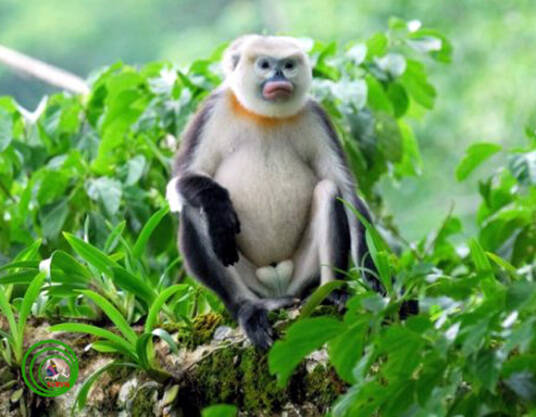Rhinopithecus avunculus
IUCN
LCBasic Information
Scientific classification
- name:Rhinopithecus avunculus
- Scientific Name:Rhinopithecus avunculus,Tonkin Snub-nosed Monkey,Tokyo snub-nosed monkey
- Outline:Primates
- Family:Monkeys
Vital signs
- length:51-65cm
- Weight:8.3-14kg
- lifetime:About 16 years
Feature
There is a bluish-black tint near the lips and an orange throat patch
Distribution and Habitat
Historically, the Vietnamese snub-nosed monkey lived in large numbers east of the Red River. As of 2008, they were confined to low-altitude subtropical rainforests in the limestone mountains between Tuyen Quang and Bac Thai provinces in northern Vietnam.
They inhabit hills and mountains formed by karst limestone and associated subtropical evergreen forests at altitudes of 200-1200 meters. The species is mainly restricted to primary forests. They do not migrate horizontally with the change of seasons, but only move vertically in their habitat.
Appearance
The Vietnamese snub-nosed monkey is a primate, with the male being larger. The head and body are 51-65 cm long, and the tail is 66-92 cm long; males weigh 13.8-14 kg, and females weigh 8.3-8.5 kg. It is an unusual and unique monkey, with a broad, flat face, a flat, upturned nose, tufts on the ears, pale blue rings around the eyes, and thick pink lips, giving the entire head an almost comical appearance. The back, the outside of the limbs and the hands and feet are all black, and the fur between the shoulders may become more brown; while the buttocks, the inside of the limbs and the elbows are creamy white; the forehead and cheeks are also cream; there is a blue-black color near the lips, and there is an orange throat patch, which is most prominent in adult males. It has a long dark brown tail, white hair on the head, and a white tuft on the top of the head.
The fur of young monkeys is gray, not black as in adults, and darkens with age, lacking the orange patch on the throat, and the
Details
Vietnamese golden monkey (scientific name: Rhinopithecus avunculus) is also known as Tonkin Snub-nosed Monkey in foreign language, and has no subspecies.

Vietnamese golden monkeys move in small groups, usually consisting of one male and multiple females, or groups of multiple males, with multiple small groups sharing a habitat. They are active during the day, crawling on all fours, climbing and jumping, and even hanging from branches. Although some activities also occur on the ground, they usually pass through the forest canopy and spend more time in the trees.
The Vietnamese golden monkey is distributed in northern Vietnam and is very rare. Due to the destruction of the ecological environment, forest degradation and fragmentation, extensive deforestation caused by human planting, development, road construction, legal and illegal logging, gold mining and commercial collection of non-timber forest products are the main reasons for the extinction of this species. Although Vietnam's national protection strategy began to be implemented in 1985, the implementation has been poor. Conservation measures include planning protected areas and prohibiting hunting, but the situation facing this species is still not optimistic. Even if the Na Hang Nature Reserve is established, the probability of extinction of the Vietnamese golden monkey is still high. A study by the Tat Ke Department of the Na Hang Nature Reserve in Vietnam in 1993 estimated the density to be less than 8 per square kilometer; a later study in 2004-2005 found a much lower density. Since this species may appear in other areas where it has not been recorded, the global population may actually be higher, estimated at about 250 (2006).
Listed in the 2008 Red List of Endangered Species of the World Conservation Union (IUCN) ver3.1-Critically Endangered (CR).
National first-class protected terrestrial wildlife.
Protect wild animals and stop eating game.
Maintaining ecological balance is everyone's responsibility!








